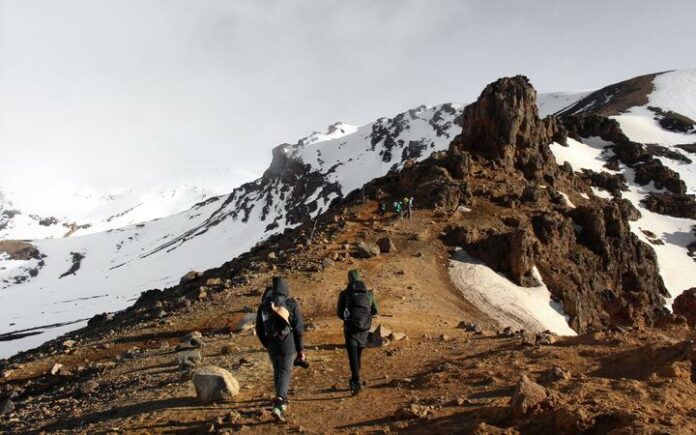“STOP: Hiking the Tongariro Alpine Crossing is NOT RECOMMENDED TODAY” – that’s the sign that will greet anyone trying to tramp one of the country’s most popular walks in bad weather this summer.
The Department of Conservation (DOC) will display the warnings on signs on the roads leading to the crossing, signs at the start and end of the track, before the Devil’s Staircase and will have rangers telling trampers in person to turn back.
Each year, about 140,000 people walk the challenging 19.4 kilometre day hike.
Tongariro Public Safety Senior Ranger Theo Chapman said DOC was worried about the risk of multiple fatalities on a bad weather day.
“Given the volume of use … and the inexperience of many people, there’s a real risk that we’ll see a large group of people heading up onto the track in bad weather, the weather’s even worse than forecast, and us having a really serious event on our hands,” Mr Chapman said.
On average, 30 to 40 people are rescued on the popular day walk each year.
Earlier this month, a woman died when she separated from her group after they took a wrong turn.
The advisory was aimed to help visitors make informed and safe decisions, he said.
“Many track users are not experienced hikers, misjudge how challenging the track is and are often not appropriately dressed or prepared for changeable alpine weather conditions.
“The advisory will be implemented alongside other initiatives aimed at ensuring our visitors are safe and have a great experience.”
From one direction, the first hour along the track is sheltered, well formed and fairly flat over volcanic rock and tussock.
But the rest of the track has unpredictable weather, steep climbs, uneven ground and exposed ridges.
People walking in summer often assumed they would have good weather, but extreme conditions – heavy rain, strong wind, snow and freezing temperatures – could hit in any season and there was no decent shelter, Mr Chapman said.
While bad weather might not be the cause of the issue a walker faced, it greatly increased the consequences, Mr Chapman said.
“The Tongariro Alpine Crossing is not a memorable experience for the right reasons on a bad day. You know most people find that they don’t enjoy the track at all if they choose to go over in bad weather.
“So our message is it’s a very challenging hike. It’s not necessarily for everyone. If you haven’t done a lot of hiking, it’s probably better to choose a shorter track.”
How the advisories will work
The bad weather advisories will be triggered when wind chill reaches minus 10 degrees or colder on a fine day, zero or less when there’s any rain or snow, if severe weather warning is issued for the national park, when wind speeds reach above 65 kilometres an hour or above 50 kilometres an hour when more than 10 millimetres of rain is predicted during a six-hour period.
Each day, rangers at Tongariro will make the call on the ground, deploying signs at the start and end of the track, at the Tongariro National Park Visitor Centre, and before the steep Devil’s Staircase section.
Electronic signs will also be installed on highways at both road ends.
Positive response
Taupō Police Senior Constable Barry Shepherd said one fatality or nasty injury was one too many.
“That’s the sort of thing that we hope this new initiative this summer, with the new signs, the information from the Conservation Department saying that the Crossing is not recommended today (will prevent),” Mr Shepherd said.
“We hope people will take notice and will avoid some of the misery some people suffer.”
Signs could make a difference with fewer people needing rescues after references to the Ngauruhoe and Tongariro summit routes were removed ahead of last summer, he said.
Mountain Safety Council chief executive Mike Daisley said there was no silver bullet solution, but people were working hard to keep walkers safe on the crossing.
People visiting the national park often had tight schedules which meant some were prepared to attempt the walk in poor condition rather than risk missing out and the rate of incidents had risen, he said.
“In the last seven years, we’ve grown from a search and rescue one in every 5000 participants that are going on the Tongariro Alpine Crossing to now doing one in every 2000. Rough numbers. Participation is not the main driver.”
Land Search and Rescue chief executive Carl McOnie hoped the new initiatives would make a difference.
“Especially in places like Tongariro Alpine Crossing, it is an alpine environment. The weather can play a major effect on people’s survivability if they get caught out in it so … preloading those people with all the information that they have to make good, logical decisions,” Mr McOnie said.
“Hopefully they don’t end up in a situation that they need our help.”
DOC will officially launch the new initiatives on Friday and they will run until the end of the summer walking season.
The advisory will be applied if any of the following parameters are exceeded at midday or 6pm for the MetService forecast at Red Crater on the walk:
- Wind speed of 65 km per hour or greater between the time of 6am to 6pm
- Wind speed of 50 km per hour or greater and precipitation of 10mm or more between 6am and 12pm, or 12pm and 6pm
- Wind chill of minus 10 degrees Celsius or colder on a fine day
- Wind chill of 0 degrees Celsius or colder with any amount of precipitation
- Severe Weather Warning issued for Tongariro National Park
Source - rnz





























